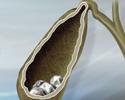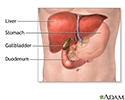Acute cholecystitis
Cholecystitis - acute; Gallstones - acute cholecystitis
Acute cholecystitis is sudden swelling and irritation of the gallbladder. It causes severe belly pain.
Causes
The gallbladder is an organ that sits below the liver. It stores bile, which is produced in the liver. Your body uses bile to digest fats in the small intestine.
Acute cholecystitis occurs when bile becomes trapped in the gallbladder. This often happens because a gallstone blocks the cystic duct, the tube through which bile travels into and out of the gallbladder. When a stone blocks this duct, bile builds up, causing irritation and pressure in the gallbladder. This can lead to swelling and infection.
Other causes include:
- Serious illnesses, such as HIV or diabetes
- Tumors of the gallbladder (rare)
Some people are more at risk for gallstones. Risk factors include:
- Being female
- Pregnancy
- Hormone therapy
- Older age
- Being Native American or Hispanic
- Obesity
- Losing or gaining weight rapidly
- Diabetes
Sometimes, the bile duct becomes blocked temporarily. When this occurs repeatedly, it can lead to long-term (chronic) cholecystitis. This is swelling and irritation that continues over time. Eventually, the gallbladder becomes thick and hard. It does not store and release bile as well as it did.
Symptoms
The main symptom is pain in the upper right side or upper middle of your belly that usually lasts at least 30 minutes. You may feel:
- Sharp, cramping, or dull pain
- Steady pain
- Pain that spreads to your back or below your right shoulder blade
Other symptoms that may occur include:
- Clay-colored stools
- Fever
- Nausea and vomiting
- Yellowing of skin and whites of the eyes (jaundice)
Exams and Tests
Your health care provider will perform a physical exam and ask about your symptoms. During the physical exam, you will likely have pain when the provider touches your belly.
Your provider may order the following blood tests:
- Amylase and lipase
- Bilirubin
- Complete blood count (CBC)
- Liver function tests
Imaging tests can show gallstones or inflammation. You may have one or more of these tests:
- Abdominal ultrasound
- Abdominal CT scan or MRI scan
- Abdominal x-ray
- Oral cholecystogram
- Gallbladder radionuclide scan
Treatment
If you have severe belly pain, seek medical attention right away.
In the emergency room, you'll be given fluids through a vein. You also may be given antibiotics to fight infection.
Cholecystitis may clear up on its own. However, if you have gallstones, you will probably need surgery to remove your gallbladder.
Nonsurgical treatment includes:
- Antibiotics you take at home to fight infection
- Low-fat diet (if you are able to eat)
- Pain medicines
You may need emergency surgery if you have complications such as:
- Tissue death (gangrene) of the gallbladder
- A hole that forms in the wall of the gallbladder (perforation)
- Inflamed pancreas (pancreatitis)
- Persistent bile duct blockage
- Inflammation of the common bile duct
If you are very ill, a tube may be placed through your belly into your gallbladder to drain it. Once you feel better, your provider may recommend that you have surgery.
Outlook (Prognosis)
Most people who have surgery to remove their gallbladder recover completely.
Possible Complications
Untreated, cholecystitis may lead to any of the following health problems:
- Empyema (pus in the gallbladder)
- Gangrene
- Injury to the bile ducts draining the liver (may occur after gallbladder surgery)
- Pancreatitis
- Perforation
- Peritonitis (inflammation of the lining of the abdomen)
When to Contact a Medical Professional
Contact your provider if you have:
- Severe belly pain that does not go away
- Symptoms of cholecystitis return
Prevention
Removing the gallbladder and gallstones will prevent further attacks.
References
Glasgow RE. Treatment of gallstone disease. In: Feldman M, Friedman LS, Brandt LJ, eds. Sleisenger and Fordtran's Gastrointestinal and Liver Disease. 11th ed. Philadelphia, PA: Elsevier; 2021:chap 66.
Radkani P, Hawksworth J, Fishbein T. Biliary system. In: Townsend CM Jr, Beauchamp RD, Evers BM, Mattox KL, eds. Sabiston Textbook of Surgery. 21st ed. St Louis, MO: Elsevier; 2022:chap 55.
Wang DQ-H, Afdhal NH. Gallstone disease. In: Feldman M, Friedman LS, Brandt LJ, eds. Sleisenger and Fordtran's Gastrointestinal and Liver Disease. 11th ed. Philadelphia, PA: Elsevier; 2021:chap 65.
Gallstones
Animation
Digestive system - illustration
Digestive system
illustration
Cholecystitis, CT scan - illustration
Cholecystitis, CT scan
illustration
Cholecystitis - cholangiogram - illustration
Cholecystitis - cholangiogram
illustration
Cholecystolithiasis - illustration
Cholecystolithiasis
illustration
Gallstones, cholangiogram - illustration
Gallstones, cholangiogram
illustration
Gallbladder removal - Series
Presentation
Digestive system - illustration
Digestive system
illustration
Cholecystitis, CT scan - illustration
Cholecystitis, CT scan
illustration
Cholecystitis - cholangiogram - illustration
Cholecystitis - cholangiogram
illustration
Cholecystolithiasis - illustration
Cholecystolithiasis
illustration
Gallstones, cholangiogram - illustration
Gallstones, cholangiogram
illustration
Gallbladder removal - Series
Presentation
Review Date: 8/7/2023
Reviewed By: Michael M. Phillips, MD, Emeritus Professor of Medicine, The George Washington University School of Medicine, Washington, DC. Also reviewed by David C. Dugdale, MD, Medical Director, Brenda Conaway, Editorial Director, and the A.D.A.M. Editorial team.



























